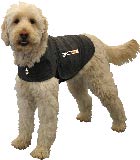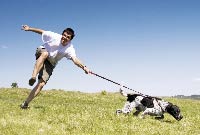We get a lot of questions at the Moab BARKery and we do our best to share our knowledge, research topics and find good answers that will help you live better with your pets. Most questions are about dogs, and it’s no wonder either. Dogs have been a fascination of the human race for thousands of years now and with all the breed diversity we have created it’s hard to have a standard answer for every question. The same question has a different answer for different types of dogs. So here are a few questions and how an answer can be very different.
Question 01: Why does my dog shake so much, are they cold? The answer is yes, no and maybe. Here’s the difference. Dogs can shake because they are cold but they can also shake if they are nervous. Many dogs that are shy or skittish will shake as a nervous response to any perceived stressful situation (a common response to coming into our store as we use the same disinfecting products in our dog wash that most vets use in their practice, i.e. our store smells like the vet). These dogs have so much anxiety built up and because of a strong fight or flight response if they can’t flee or fight, they literally have to shake it off. You see this most often in small breed dogs, but even large dogs can have this response.  Often people will buy the dog a jacket thinking they are cold, and even though they are not shaking due to being cold they stop shaking when the jacket is on. Well this works because Often people will buy the dog a jacket thinking they are cold, and even though they are not shaking due to being cold they stop shaking when the jacket is on. Well this works because
a jacket binds the body in a firm but light way and this puts pressure on the parasympathic nervous system all mammals share. According to medical definition the parasympathetic nervous system is “the part of the involuntary nervous system that serves to slow the heart rate, increase intestinal and glandular activity, and relax the sphincter muscles.” By wrapping the body and chest it’s basically like getting a hug and that calms down an overactive involuntary response (shaking) and allows the dog to recover from the perceived stress much faster. A common product sold to help dogs that overreact to normal life events like car rides, vet trips, new situations and new people is the thundershirt. It is a light but firm wrap that covers the body and chest. It’s lightweight, and made from flexible cotton/lycra blend. Many people use it as a winter jacket as well as a solution for nervous or timid dogs to deal with the stress they perceive. A very uncommon reason for your dog to shake is that their body’s ability to maintain proper temperature is compromised and this can be for many different but serious medical reasons that require immediate veterinarian attention. If it’s not cold, nor is your dog in a real or perceived stressful situation and they shake regularly call your vet and get a check up just in case.
Question 02: My dog pulls when they are on leash, do I need a harness? Again with the yes, no or maybe answers. Here’s the difference. If you have a small dog it’s dangerous for them to be on leash if they are out of control and pulling like a fast moving tether ball. They can do a decent amount of damage to their trachea with their own body weight against a collar. If they gag, cough or even wretch they need to be wearing a harness instead to prevent injury. The thing about  harnesses, is that most will actually encourage pulling. These are usually called h-style, mesh or step in harnesses. If your dog is 7 pounds, that pulling may be little to no nuisance but keep the dog safe from damaging their throat. If your dog is 70 pounds that pulling will sweep you right off your feet. Larger dogs have much less risk for damage to the throat while pulling, but wearing a harness gives them much more leverage to dig in and get moving whether you want to or not. There are many harnesses that discourage pulling, all with varying design but they are all designed to take leverage away from the dog and give it back to the human. We sell 4 different types of harnesses to help with pulling to give people many options for fit and comfort. There are also head collars, martingale style collars and training methods that can help reduce pulling in dogs of all sizes. We always recommend consistent training with these products as well to get the maximum effect of using it as a tool for a better walk. Lastly we want to say thanks to all the people who walk their dogs, even if the walk is sometimes crazy, or out of control. The more walks a wild and crazy dog gets usually the better they become on leash. Just remember to be patient, consistent and when your dog is out of control you need to be the most “in control” as possible in order for your dog to listen. harnesses, is that most will actually encourage pulling. These are usually called h-style, mesh or step in harnesses. If your dog is 7 pounds, that pulling may be little to no nuisance but keep the dog safe from damaging their throat. If your dog is 70 pounds that pulling will sweep you right off your feet. Larger dogs have much less risk for damage to the throat while pulling, but wearing a harness gives them much more leverage to dig in and get moving whether you want to or not. There are many harnesses that discourage pulling, all with varying design but they are all designed to take leverage away from the dog and give it back to the human. We sell 4 different types of harnesses to help with pulling to give people many options for fit and comfort. There are also head collars, martingale style collars and training methods that can help reduce pulling in dogs of all sizes. We always recommend consistent training with these products as well to get the maximum effect of using it as a tool for a better walk. Lastly we want to say thanks to all the people who walk their dogs, even if the walk is sometimes crazy, or out of control. The more walks a wild and crazy dog gets usually the better they become on leash. Just remember to be patient, consistent and when your dog is out of control you need to be the most “in control” as possible in order for your dog to listen.
Question 03: My dog got skunked at 2am and I wasted 3 bottles of Tomato juice trying to get it out, it didn’t work! What can I do?? The reason why tomato juice does little help is you are relying on the acids to help break down the greasy nature of skunk “spray.” It was a great solution when modern ingredients were not available, but your great-grandmothers advice is not going to help on this one. Here is what you need to do. Mix this easy to use homemade formula fresh (it can’t be stored once mixed)
• 1 quart hydrogen peroxide (the 3% hydrogen peroxide variety)
• ¼ cup baking soda
• 4 teaspoons Dawn dishwashing liquid.
*If you have a large breed dog, you may need to double, triple or even quadruple the mixture. Wear gloves to keep the skunk smell off you.
Don’t wet your pet. Apply the mixture to your pet’s dry coat from the collar back toward the tail. Don’t pour it near the eyes because the hydrogen peroxide solution can burn them. Use a sponge to apply the solution to your pet’s chin, cheeks, forehead and ears, being very careful not to go near the eyes.
Lather the mixture into your pet’s coat and skin. Rub the solution around for about five minutes or until the skunk smell starts to dissipate.
When you rinse the head area, tilt your pet’s chin upward so the solution does not run down into the eyes; instead allow the water to run back off his neck. Do a complete rinse once the smell starts to decrease, then repeat the entire process again if necessary. You may need to repeat the lather and rinse process up to three times if they took a direct hit. Make sure to completely rinse the solution off your pet. Your final rinse should be very thorough to ensure there is no irritation.
If you don’t want all the hassle of mixing up a batch for yourself the Moab BARKery carries Skunk off (premixed enzyme and degreaser that is ready to use) for convenience. It pays to keep it on hand for dogs and cats that just want to “play” with their stinky skunk friends. |